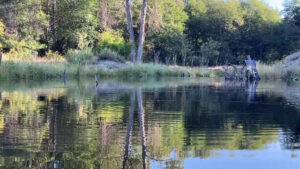“Beaver dam analogues (BDAs) are channel-spanning structures that mimic or reinforce natural
beaver dams. As such, they are semi-porous to water, sediment, fish and other
water-borne materials. Like natural beaver dams, BDAs are biodegradable, temporary features
on the landscape with functions that change in response to the effects of flowing water,
sediment, and beaver activity. Also like natural beaver dams, BDAs function
best when constructed in sequence, such that the structures work in concert with each other.
Beaver dam analogues are constructed with material that is similar to what beaver use to build
their dams. Depending on what type of BDA is constructed, this may includes sediment
ranging in size from cobbles, gravel, sand, silt and clay, vegetation such as the stalks of
emergent vegetation, the branches and stems of decidous (sic) trees and shrubs (usually willow or
cottonwood) and wood posts made from the boles of conifers. A complete
construction sequence for a BDA would be to first install a line of posts using a hydraulic or
pneumatic post pounder (Figure 25), followed by weaving branches in between the posts. An
upstream face is then constructed first using cobble and other large material placed at the
upstream base to prevent underscour, followed by successive layers of vegetation and finergrained material until the structure has achieved the desired level of flow permeability and
upstream pool depth.” – 2015 Beaver Restoration Guidebook (Chapter 6: Beaver Dam Analogues) Michael M. Pollock, Nick Weber and Greg Lewallen
By the implementation of BDAs, we will directly address stressors related to climate change and those identified for the Scott River in the SONCC Coho Salmon Recovery Plan (NMFS, 2014); “altered hydrologic function” and “degraded riparian forests”. We are working in a system that has been altered by human actions such as logging, mining, channelization and water extraction. The BDAs will increase sediment retention, raise water tables, and improve resilience of the aquatic system over time helping to remediate the past degradation. Through process-based restoration we hope to reverse channel incision; creating areas of healthily functioning streams to provide their richly diverse and resilient suite of habitat and ecosystem functions.
When using beaver mimicry, in our case BDAs, adaptive management and methodologies are essential to long term success. Process based restoration requires interventions to be dynamic and responsive to changes in a system as the intervention takes effect. To do so effectively, a systematic approach to evaluating, and responding to project impacts must take place. Similarly, for climate resilience, restoration cannot be static, but must continue to be adapted to changing climatic conditions. Process-based restoration requires a paradigm shift from “implementing a project” (the current theoretical framework for funding and permitting of restoration projects) to “watershed care”, which is a long-term commitment to care for a specific landscape. Creating this cultural change requires data and engagement with agency personnel, grant funders, and the wider restoration community.
